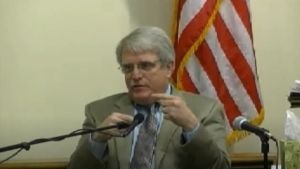

The Expert: Dr. Patrick J. O’Brien, a North Carolina-based expert in physical medicine and rehabilitation, details injuries, therapy, and future issues for the paralyzed patient.

Offering testimony in a product liability case out of North Carolina, Dr. Patrick O’Brien, a physical medicine and rehabilitation physician from Raleigh, details the injuries, therapy, and future problems facing a child who was paralyzed in an auto accident. The claim was brought due to the placement of seat belts in the car that were stabilized at only two points instead of three- point stabilization.
O’Brien initially explains that the 11-year-old patient suffered a bad fracture of the second lumbar vertebrae. In order to stabilize this, a fusion of the two vertebra above and two below that fracture was necessary. This operation in a child will affect the shape of the spine in the future as the fused segments will not grow, while the spine above this level and below will continue to grow. Such distortions of the spine can result in scoliosis, a curvature of the spine, as has been manifested by the patient’s tendency toward poor posture that cannot be easily dealt with. So far, the doctor says, this has been treated with a soft brace that is difficult for the child to use.
The paralysis and fusion together have changed his center of balance. This leaves him at risk for falling out of his chair or wheelchair. This danger became a focus of his physical therapy. The level of his paralysis has furthermore caused him to lose control of his bladder and bowel function. This complicates his rehabilitation, which has included teaching him how to transfer from bed, chair or wheelchair, dress himself with lower extremities paralyzed, and bathe himself or shower in a wheelchair. The neurogenic bladder condition, in which he is unable to feel when the bladder is full, or control its emptying, has forced the therapists to teach the child how to self-catheterize intermittently.
The expert explains in graphic detail the difficulties in dealing with the child’s lack of bowel control. Initially, his mother had to deal with trying to train his rectum for defecation using digital stimulation and suppositories. This was performed in bed, leading to constant soiling of the bedsheets. Eventually, they were able to teach this child to deal with this in a chair. Since he had surgical incisions on his abdomen as well as his back, and was unable to feel when stool or urine was coming out of him, the boy had to rely on his sense of smell to determine when these things were occurring and then act in time to prevent contamination of his wounds.
It was especially important to increase the strength of his upper body, the doctor explains. He was large for his age and now depended entirely upon the upper body for all mobilization.
The expert details how the patient’s neuropsychiatric needs have been addressed. “This has been a moving target,” due to his age, as the child has progressed to an adolescent and then to a young adult.
His mother and grandmother were originally his primary caregivers, but as he grew, he took more of this on himself. Nonetheless, it only takes 20 minutes stuck in one position for a paralyzed person to suffer a pressure injury of the skin. This patient has had two such breakdowns. These are very difficult to heal and can take up to a year to fix.
Although there have been no problems with muscle spasms to this point, the lack of any muscle movement has led to atrophy of the muscles as well as a demineralization and weakening of the bone structure, since those bones are not being used.
The doctor explains that, as he ages, the patient will encounter problems related to growing. Gaining weight will make activities of daily living more difficult for him, and he will remain at high risk for skin breakdown, urinary tract infections, complications from incontinence, fractures of his lower legs and ankles, shoulder and upper back problems, and carpal tunnel syndrome.
The rehabilitation expert painted a picture of a very sympathetic patient who is being as cooperative as possible, but faces a lifetime of very difficult problems and complications. His testimony led to an unpublished settlement while the jury was deliberating.
Gary Gansar, MD, is residency-trained in general surgery. He served as Chief of Surgery and Staff at Elmwood Medical Center and on the Medical Executive Committee at Touro Infirmary and Mercy Hospital in New Orleans, LA. Dr. Gansar was Board Certified in general surgery while in active practice. He joined AMFS in 2015 as a Physician Medical Director.
The medical expert witness partner for attorneys serious about building a winning case
AMFS is your trusted source for highly-qualified medical expert witnesses. After pioneering the field nearly three decades ago, we’re continuing to redefine medical expert witness services by providing value far beyond a referral alone.
Our Physician Medical Directors know what it takes to build a strong case. Our medical expert witnesses leave no doubt. And our case managers streamline billing and logistics every step of the way, letting you focus on what you do best: constructing your winning case. Explore why AMFS clients expect more from their medical expert witnesses—and get it.
